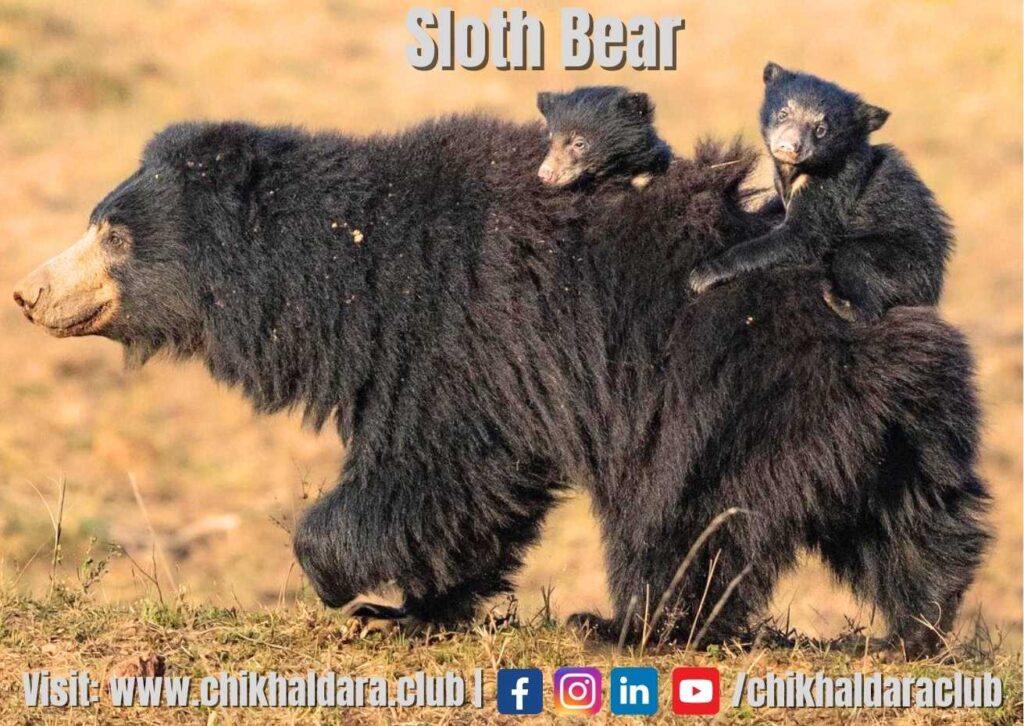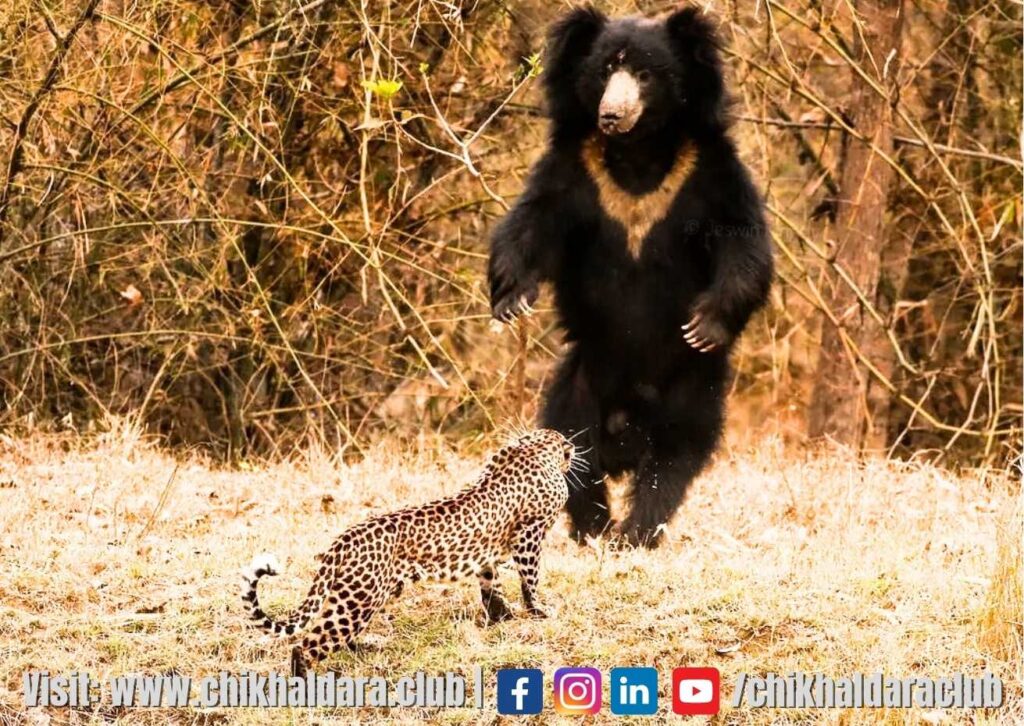Table of Contents
The sloth bear (Melursus ursinus) is a species of bear that is found in the Indian subcontinent. These fascinating animals are known for their long, shaggy black fur and distinctive white V-shaped markings on their chests. Sloth bears are an important part of India’s wildlife and are revered in many cultures.
Physical Characteristics
Sloth bears are medium-sized bears, weighing between 80-140 kg. They have a long, shaggy coat of black fur that protects them from the sun, and distinctive white V-shaped markings on their chests. Sloth bears have long, curved claws that they use to dig for insects and other small animals in the ground. They also have a long, sticky tongue that helps them to extract termites and other insects from their nests.
Habitat and Distribution
Sloth bears are primarily found in India, but their range also extends to parts of Nepal, Bhutan, Bangladesh, and Sri Lanka. They prefer forested areas and grasslands, where they can find food and shelter. Sloth bears are adaptable to a range of habitats and can survive in both tropical and sub-tropical environments.
Diet of Sloth Bear
Sloth bears are omnivorous and primarily feed on insects, including termites and ants. They also eat fruits, nuts, and honey. Sloth bears are known for their unique feeding behavior, in which they use their long claws to tear apart termite mounds and anthills, and then use their long, sticky tongue to extract the insects.

Sloth Bear Life Span
The average lifespan of a sloth bear is around 20-30 years in the wild, although they can live longer in captivity. Factors such as habitat quality, availability of food, and human-wildlife conflict can impact their lifespan. Female sloth bears typically have a longer lifespan than males. In captivity, sloth bears have been known to live up to 40 years. However, in the wild, their lifespan is impacted by various factors such as disease, predation, and habitat loss, making it difficult to determine an exact lifespan for the species.
Sloth Bear Size and Weight
Sloth bears are medium-sized bears, with males typically being larger than females. Adult males can weigh anywhere from 120 to 310 pounds (55 to 140 kg) and have a body length of up to 6 feet (1.8 meters). Females are generally smaller, weighing between 120 to 210 pounds (55 to 95 kg) and measuring up to 5.5 feet (1.7 meters) in body length. Sloth bears have a distinctive shaggy black coat and a white or cream-colored V-shaped mark on their chest. They have long, curved claws which they use for digging into termite mounds and anthills to extract insects.
Behavior and Social Structure
Sloth bears are solitary animals and are primarily active at night. They are excellent climbers and swimmers, and can also run at high speeds when threatened. Sloth bears are generally docile animals and are not known to be aggressive unless they feel threatened or cornered.
Sloth Bear Population in India
According to the latest estimate from the Indian government’s Census report released in 2023, there are an estimated 9,000 to 10,000 sloth bears in India. However, sloth bears are still considered vulnerable due to habitat loss, hunting, and human-wildlife conflict. Conservation efforts are underway to protect the remaining populations in India, including habitat restoration, reducing human-wildlife conflicts, and implementing stricter laws against poaching and wildlife trade.
Conservation Status
Sloth bears are listed as vulnerable on the IUCN Red List of Threatened Species. Their population is declining due to habitat loss, hunting, and human-wildlife conflicts. Sloth bears are sometimes killed by farmers who see them as a threat to their crops, and they are also hunted for their body parts, which are used in traditional medicine.
Conservation efforts are underway to protect the remaining populations of sloth bears in India. The Indian government has established several protected areas, including national parks and wildlife sanctuaries, where sloth bears can live and breed safely. These protected areas also promote conservation education and awareness among local communities, and encourage sustainable tourism that supports local livelihoods.
How can I see sloth bears in India ?
Sloth bears can be seen in Melghat Tiger Reserve and other national parks in India.
You need to book jungle safari and try to find the sloth bear during jungle safari.
To increase your chances of seeing sloth bears, it is best to visit these parks during the dry season (November to May) when the bears are more active and visible. It is important to hire a trained guide and follow the park’s rules and regulations to ensure the safety of both visitors and wildlife.
Find More about;
Melghat Tiger Safari
Chikhaldara Jungle Safari
Semdoh Jungle Safari
Summary
Sloth bears are an important and fascinating species in India’s wildlife. They play an important role in maintaining ecological balance and are an important part of India’s cultural heritage. It is important to continue efforts to protect and conserve sloth bears and their habitats to ensure that future generations can appreciate and enjoy these magnificent animals.
Frequently Asked Questions | FAQs
What’s special about sloth bear?
Sloth bears are known for their distinctive long, shaggy black fur and distinctive white V-shaped markings on their chests. They have a unique feeding behavior in which they tear apart termite mounds and anthills with their long claws, and then extract the insects with their long, sticky tongues. They are also excellent climbers and swimmers, and are an important part of India’s cultural heritage.
What is Indian sloth bear?
The Indian sloth bear is a species of bear that is found primarily in India, but also in parts of Nepal, Bhutan, Bangladesh, and Sri Lanka. They are known for their long, shaggy black fur and distinctive white V-shaped markings on their chests, and are listed as vulnerable due to habitat loss, hunting, and human-wildlife conflicts. Sloth bears are important for maintaining ecological balance and are an important part of India’s wildlife and cultural heritage.
Where is sloth bear found in India?
Sloth bears are primarily found in forested areas of India, including the Western Ghats, Central India, and the Himalayan foothills. They can also be found in dry and arid regions of India, such as the Ranthambore National Park in Rajasthan. Sloth bears prefer habitats with plenty of vegetation and are known to inhabit both tropical and temperate forests, as well as grasslands and scrublands.
Are sloth bear dangerous ?
Sloth bears are generally not considered to be aggressive towards humans, but they can become dangerous if they feel threatened or if their cubs are in danger. Like all wild animals, it is important to maintain a safe distance and avoid provoking them. In rare cases, sloth bears have been known to attack humans, so it is important to exercise caution and follow proper safety guidelines when encountering them in the wild.


